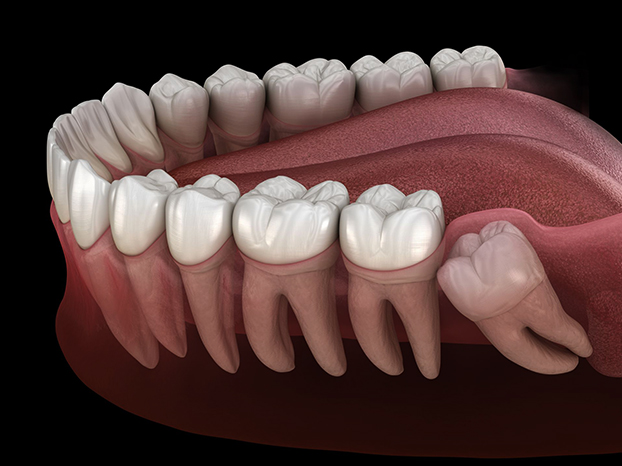Wisdom Teeth Extraction

Remove Wisdom Teeth for Lasting Relief
Wisdom Teeth Extraction Explained
The term "wisdom teeth" refers to the third set of molars located at the back of the mouth, typically emerging between the ages of 17 and 21. While the emergence of wisdom teeth can be uncomfortable, they do not always require extraction. Properly aligned wisdom teeth can actually aid in chewing.
However, if there is insufficient space for the wisdom teeth to emerge or if they are coming in at the wrong angle, they may become impacted, leading to potential issues such as cysts, damage to neighboring teeth, gum disease, infection, pain, tooth decay, and tumors. It is important for a dentist to monitor the patient's wisdom teeth and determine the best course of action. Learn more about wisdom teeth here.
“Wisdom teeth” is the colloquial term for the third set of molars that sit in the back of the mouth.”
What to Know Before Wisdom Teeth Extraction
- Absent or dislodged blood clot at the extraction site after surgery
- High temperature
- Yellow or white discharge from the extraction site
- Persistent pain and swelling
- Persistent, heavy bleeding that does not subside over time
- Throbbing pain in the gum or jaw
- Unpleasant smell or taste in the mouth
“Wisdom teeth extraction is commonly performed and generally safe when carried out by qualified doctors.”
Getting ready for Wisdom Teeth Removal
“The first step to wisdom teeth extraction begins with an initial consultation.”
Expectations for Wisdom Teeth Extraction
In general, the process of wisdom teeth extraction typically involves the doctor administering a local anesthetic to numb the patient before beginning the procedure. The doctor will then cut into the gum tissue to expose the tooth and bone, ensuring that any bone obstructing access to the tooth root is removed. In some cases, the tooth may need to be divided into sections for easier removal.
Once the tooth has been extracted, the doctor will clean the extraction site to remove any debris. Depending on the situation, stitches may or may not be necessary, and gauze will be packed over the site to control bleeding and promote the formation of a blood clot.
“After extracting the tooth, the doctor will clean the extraction site of any debris.”
Wisdom Teeth Extraction Aftercare
After having their wisdom teeth extracted, patients should plan to rest for the rest of the day. While they can return to their regular activities the next day, they should avoid any strenuous activity for at least a week to prevent overexertion and dislodging the blood clot. Our team will create a personalized recovery plan for each patient.
Complications after wisdom teeth extraction are uncommon if patients adhere to this plan. If patients experience any of the following, they should contact us right away:
- Blood or pus in nasal discharge
- Difficulty swallowing or breathing
- Excessive bleeding
- Fever
- Foul taste in the mouth
- Persistent numbness or loss of feeling
- Pus in or oozing from the socket
- Severe pain that does not subside
- Swelling that does not subside after two or three days




